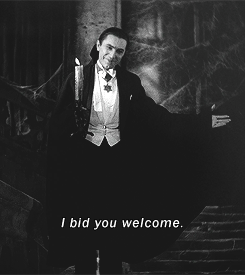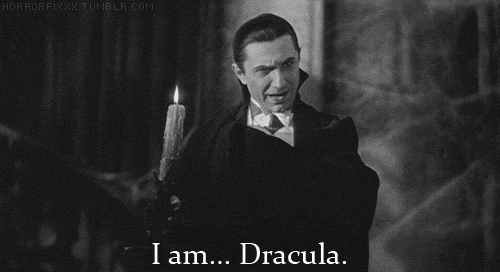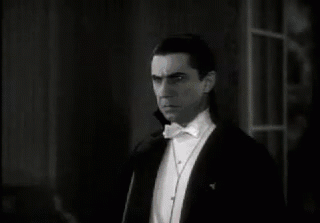#NurseryCrimes: A criminally fresh perspective on fairytales, nursery rhymes, villains, heroes and literary monsters.

Once upon a late night, I read Bram Stoker’s Dracula. In the book, mysterious puncture marks had begun appearing on the necks of townswomen and several characters had become unwitting hosts to winged creatures who tapped at their windows at night.
Entertained, but incredulous, I put the book down and nodded off. A few hours later, I woke to a flurry of tiny wings fanning my face. The mysterious late night visitor revealed itself, to my horror, to be a bat circling the beams above my head.
The rest of this story rapidly devolves into a comedy of errors involving army-crawling to safety, the rousing and disbelief of room mates, and one final and spectacular showdown between four adults, a tiny bat and a broom.

Literary monsters such as Dracula take root in our deepest and most primal fears because they are not restricted by the laws of man or the laws of nature. They are formidable predators, undead, invisible to society and materialise from your worst nightmares (and your bedroom).
The point is that life often imitates art – my improbable bat tale is evidence. As dark and unimaginable as fictionalised horror stories can be, everyday life can be equally unpredictable and frightening.
But what many of us tend to forget is that the law is an equally powerful and dynamic entity that is there to protect us from all manner of evil.
Lawyering Is Thirsty Work
Lawyers have long-been been regarded by society as blood sucking vampires who prey on the vulnerable and weak for their own gain. But ironically, lawyers are well-represented in Stoker’s famous 1897 work, Dracula, as the heroes of the story. For example, lead characters Jonathan Harker and Van Helsing.
The difference in our modern 2015 reworking of Dracula is that, unlike many women portrayed in Stoker’s narrative, this story will not end with victims going gently into the night succumbing to Dracula’s supernatural spell. In this rendition, Dracula will be put on trial.
Crimes That Count
In many ways Stoker’s story is a reflection of society.
Unthinkable crimes committed by unseen predators lurking in our midst (for example, serial killers, pedophiles, kidnappers, stalkers and rapists) occur with a similar methodology to Dracula. News stories about violent criminal activity affect us with a combination of awe and abhorrence as they shine a light on the worst acts humanity is capable of. Perhaps the most important thing Dracula teaches us is that:
You do not have to be a fictitious monster to commit monstrous acts. Click To TweetThe law regulates our behaviour by spelling out conduct that is, and is not, acceptable. It holds a mirror up to the values of the society of the day so that behaviour that causes community harm, that is morally wrong or offensive or impinges on another person’s individual autonomy is punished.

With this framework in mind, what crimes could Dracula be charged with if he were prosecuted in a modern Australian court?
False Imprisonment
Dracula locks Jonathan Harker in a room in his castle.
In no place [in the castle] save from the windows in the castle walls is there an available exit.The castle is a veritable prison, and I am a prisoner!” – Jonathan Harker, Dracula
False imprisonment is a common law offence in NSW, it is a crime to intentionally and unlawfully restrain the liberty of another person against their will.

However, for Dracula to be charged with the criminal offence of false imprisonment, he would need to detain Jonathan Harker in NSW, rather than in his damp Transylvanian castle.
Dracula could also be sued civilly by Jonathan Harker for false imprisonment, with a sum of damages to be determined by the court.
Identity Theft
Jonathan Harker witnesses Dracula crawling down the castle wall in Harker’s clothes. He realises Dracula’s dark motive is to appear publicly and remove the possibility of Harker’s disappearance to be traced to Dracula’s castle.

I had been at the window somewhat less than half an hour, when I saw something coming out of the Count’s window. I drew back and watched carefully, and saw the whole man emerge. It was a new shock to me to find that he had on the suit of clothes which I had worn whilst travelling here, and slung over his shoulder the terrible bag which I had seen the women take away. There could be no doubt as to his quest, and in my garb, too! This, then, is his new scheme of evil, that he will allow others to see me, as they think, so that he may both leave evidence that I have been seen in the towns or villages posting my own letters, and that any wickedness which he may do shall by the local people be attributed to me.” – Jonathan Harker, Dracula
Identity theft is considered a dishonesty offence. In Australia, using another person’s personal information with intention to commit an indictable offence is a crime. It may also be proven that Dracula engaged in fraud by unlawfully obtaining property belonging to Jonathan with the intention to permanently deprive him of it.
Stalking
Lucy Westenra and Mina Harker are stalked by Dracula.

I have a dim half remembrance of long, anxious times of waiting and fearing, darkness in which there was not even the pain of hope to make present distress more poignant. And then long spells of oblivion, and the rising back to life as a diver coming up through a great press of water. Since, however, Dr. Van Helsing has been with me, all this bad dreaming seems to have passed away. The noises that used to frighten me out of my wits, the flapping against the windows, the distant voices which seemed so close to me, the harsh sounds that came from I know not where and commanded me to do I know not what, have all ceased – Lucy Westenra, Dracula
In Australia, stalking is a crime in every State and Territory.
Under the Crimes Act 1900, stalking must occur on more than one occasion. In NSW stalking legislation has been made in tandem with domestic violence legislation in the Crimes (Domestic & Personal Violence) Act 2007, NSW.
To constitute stalking, Dracula must have engaged in watching and being in the vicinity of Lucy or Mina’s homes, business or work or any place they frequent for social or leisure activities.
It is clear that Lucy Westenra is aware that she is being stalked and that her assailant is causing her physical harm. Dracula’s nightly stalking behaviour was intended to cause fear of physical or mental harm.
The maximum penalty is 5 years imprisonment.
Assault
Lucy Westernra and Mina Harker are victims of assault. Lucy, in particular, is preyed upon at night by Dracula when she is regularly bitten and her blood exsanguinated.

I was waked by the flapping at the window… I heard a sort of howl like a dog’s, but more fierce and deeper. I went to the window and looked out, but could see nothing, except a big bat, which had evidently been buffeting its wings against the window. – Lucy Westrnra, Dracula.
Dracula may be charged with assault occasioning actual bodily harm. The injuries caused do not need to be permanent but must require serious physical injury and wounding.
The maximum penalty is 5 years imprisonment.
Poisoning
When Dracula bites Lucy Westenra, he infects her blood. Her blood poisoning places her under his spell where she is compelled to do his bidding as the ‘bloofer lady.’
She stalks children at night and eventually transforms into an undead vampire herself.
Another child, missed last night, was only discovered late in the morning …It has the same tiny wound in the throat as has been noticed in other cases. It was terribly weak, and looked quite emaciated. It too, when partially restored, had the common story to tell of being lured away by the “bloofer lady”.
It is a criminal offence to endanger life or inflict grievous bodily harm.
To be successfully charged, it would need to be established that Dracula administered a poisonous or intoxicating substance or other destructive or noxious thing, that it endangered life or inflicted grievous bodily harm and that Dracula intended to injure, or was reckless about injuring Lucy.
The maximum penalty is 10 years imprisonment.
Trespass
Dracula frequently lets himself into the houses of his victims without permission through windows and locked doors.

I’ll just let myself in
In NSW, someone can only enter your property if you have given them permission, or if they have a right of way or other right of access to your land.
Entering property without permission is trespassing.
Dracula could be prosecuted for trespass and/or sued under civil law for damages.
Manslaughter
Lucy Westenra’s mother dies from shock when she sees Dracula in the form of a wolf at Lucy’s window.

There was a crash at the window, and a lot of broken glass was hurled on the floor. The window blind blew back with the wind that rushed in, and in the aperture of the broken panes there was the head of a great, gaunt gray wolf.
Mother cried out in a fright …for a second or two she sat up, pointing at the wolf, and there was a strange and horrible gurgling in her throat. Then she fell over, as if struck with lightning, and her head hit my forehead …dear Mother’s poor body, which seemed to grow cold already, for her dear heart had ceased to beat, weighed me down, and I remembered no more for a while. – Lucy Westenra – Dracula.
Manslaughter can be either voluntary or involuntary or through criminal negligence. In Dracula’s case we are only interested in voluntary manslaughter through unlawful and dangerous act. Dracula caused the death of Mrs Westenra by his voluntary act of smashing through the window which was unlawful and dangerous.
It would need to be proven that a reasonable person in Dracula’s position would have appreciated that such an act would expose another person to a risk of serious injury.
A court would also take into account Mrs Westenra’s age and whether she had an underlying medical or heart condition.
The maximum penalty is 25 years imprisonment
Murder
The question of whether Dracula could be charged with murder is a tricky one since Lucy Westenra did not die, but rather became undead.

To successfully bring a charge of murder against Dracula under the NSW Crimes Act 1900, it would need to be established beyond a reasonable doubt that Dracula voluntarily engaged in an action (or omission) that caused death and had the requisite mental element of either killing or inflicting grievous bodily harm or was recklessly indifferent to human life.
A more appropriate charge, given current development of the law, could be wounding with intent to cause grievous bodily harm which is generally considered under common law to involve breaking of the skin. Wounding does not require use of a weapon – as Dracula proves by the use of his fangs.
To be guilty of this offence, Dracula must have wounded Lucy and caused grievous bodily harm with the intent to cause that grievous bodily harm. Given the extent and nature of her injuries, the degree of violence and ferocity of attack as well as her transformation into a vampire will be taken into account in sentencing.
The maximum penalty is 25 years imprisonment.
A Final Nail In The Coffin
No one is impervious to prosecution. Not even literary monsters.
As heinous as these crimes in the time of a fictional character may seem, humans are equally capable of committing terrible and violent acts against one another. The law exists to regulate this behaviour so that any action which causes harm to a person is punished.
Enjoy this story? Subscribe to our newsletter to have our latest #NurseryCrime tales delivered straight to your inbox!

 Agree? Get informed about legal change that impacts you with our newsletter. You'll automatically receive fresh content each time we publish.
Agree? Get informed about legal change that impacts you with our newsletter. You'll automatically receive fresh content each time we publish.